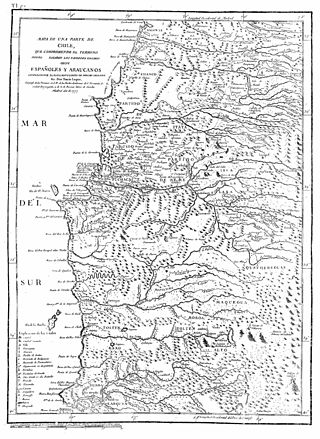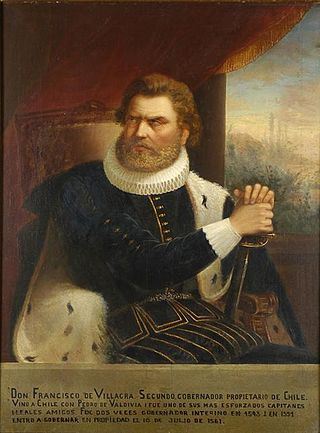
Pedro Gutiérrez de Valdivia or Valdiva was a Spanish conquistador and the first royal governor of Chile. After serving with the Spanish army in Italy and Flanders, he was sent to South America in 1534, where he served as lieutenant under Francisco Pizarro in Peru, acting as his second in command.

The Strait of Magellan, also called the Straits of Magellan, is a navigable sea route in southern Chile separating mainland South America to the north and Tierra del Fuego to the south. The strait is considered the most important natural passage between the Atlantic and Pacific oceans. It was navigated by canoe-faring indigenous peoples including the Kawésqar for thousands of years. In 1520, the Spanish expedition of Ferdinand Magellan, after whom the strait is named, became the first Europeans to discover it.

La Araucana is a 16th-century epic poem in Spanish by Alonso de Ercilla, about the Spanish Conquest of Chile. It was considered the national epic of the Captaincy General of Chile and one of the most important works of the Spanish Golden Age.

Inés Suárez, was a Spanish conquistadora who participated in the Conquest of Chile with Pedro de Valdivia, successfully defending the newly conquered Santiago against an attack in 1541 by the indigenous Mapuche.

Quillota is a city located in the Aconcagua River valley in central Chile's Valparaíso Region. It is the capital and largest city of Quillota Province, where many inhabitants live in the outlying farming areas of San Isidro, La Palma, Pocochay, and San Pedro. It is an important agricultural center, mainly because of the plantations of avocado and cherimoya trees.

The Arauco War was a long-running conflict between colonial Spaniards and the Mapuche people, mostly fought in the Araucanía. The conflict began at first as a reaction to the Spanish conquerors attempting to establish cities and force Mapuches into servitude. It subsequently evolved over time into phases comprising drawn-out sieges, slave-hunting expeditions, pillaging raids, punitive expeditions, and renewed Spanish attempts to secure lost territories. Abduction of women and war rape was common on both sides.

Francisco de Villagra Velázquez was a Spanish conquistador, and three times governor of Chile.

The Captaincy General of Chile or Governorate of Chile, was a territory of the Spanish Empire from 1541 to 1817 that was, for most of its existence, part of the Viceroyalty of Peru. It comprised most of modern-day Chile and southern parts of Argentina. Its capital was Santiago de Chile. In 1810 it declared itself independent, but in 1814 the Spanish reconquered the territory, but in 1817 it gained independence as the Republic of Chile. It had a number of Spanish governors over its long history and several kings.

The Battle of Tucapel is the name given to a battle fought between Spanish conquistador forces led by Pedro de Valdivia and Mapuche (Araucanian) Indians under Lautaro that took place at Tucapel, Chile on December 25, 1553. This battle happened in the context of the first stage of the Arauco War, named the "offensive war" within a larger uprising by Araucanians against the Spanish conquest of Chile. It was a defeat for the Spaniards, resulting in the capture and eventual death of Valdivia.

Valdivia is a city and commune in southern Chile, administered by the Municipality of Valdivia. The city is named after its founder, Pedro de Valdivia, and is located at the confluence of the Calle-Calle, Valdivia, and Cau-Cau Rivers, approximately 15 km (9 mi) east of the coastal towns of Corral and Niebla. Since October 2007, Valdivia has been the capital of Los Ríos Region and is also the capital of Valdivia Province. The national census of 2017 recorded the commune of Valdivia as having 166,080 inhabitants (Valdivianos), of whom 150,048 were living in the city. The main economic activities of Valdivia include tourism, wood pulp manufacturing, forestry, metallurgy, and beer production. The city is also the home of the Austral University of Chile, founded in 1954 and the Centro de Estudios Científicos.

Jerónimo de Alderete y Mercado was a Spanish conquistador who was later named governor of Chile, but died before he could assume his post.
The battle of Andalien, fought in early February 1550, was a night battle between 20,000 Mapuche under the command of their Toqui Ainavillo and Pedro de Valdivia's army of 200 Spanish soldiers and cavalry with a large number of yanakuna, including 300 Mapochoes auxiliaries under their leader Michimalonco.
Battle of Quilacura was a battle in the Arauco War, fought at night, four leagues from the Bio-Bio River, between the Spanish expedition of Pedro de Valdivia and a force of Mapuche warriors led by Malloquete on February 11, 1546.
The Battle of Penco, on March 12, 1550, was a battle between 60,000 Mapuche under the command of their toqui Ainavillo with his Araucan and Tucapel allies and Pedro de Valdivia's 200 Spaniards on horse and afoot with many yanakuna including 300 Mapochoes auxiliaries under their leader Michimalonco, defending their newly raised fort at Penco. It was part of a war.
Jerónimo de Vivar was a Spanish historian of the early conquest and settlement of the Kingdom of Chile, and author of Crónica y relación copiosa y verdadera de los reinos de Chile.

The Conquest of Chile is a period in Chilean historiography that starts with the arrival of Pedro de Valdivia to Chile in 1541 and ends with the death of Martín García Óñez de Loyola in the Battle of Curalaba in 1598, and the destruction of the Seven Cities in 1598–1604 in the Araucanía region.

Inca rule in Chile lasted from the 1470s to the 1530s when the Inca Empire was absorbed by Spain. The main settlements of the Inca Empire in Chile lay along the Aconcagua, Mapocho and Maipo rivers. Quillota in Aconcagua Valley was likely the Incas' foremost settlement. The bulk of the people conquered by the Incas in Central Chile were Diaguitas and part of the Promaucae. Incas appear to have distinguised between a "province of Chile" and a "province of Copayapo" neighboring it to the north. In Aconcagua Valley the Incas settled people from the areas of Arequipa and possibly also the Lake Titicaca.

Pedro Sánchez de la Hoz or Pedro Sancho de la Hoz was a Spanish merchant, conquistador and adelantado who served as secretary to Pizarro. In 1534 he obtained the rights of a capitulación de conquista south of the Straits of Magellan. He was appointed by Charles V, Holy Roman Emperor as an adelantado of the Governorate of Terra Australis in 1539.
In the late 16th century, the Spanish Empire attempted to settle the Strait of Magellan with the aim of controlling the only known passage between the Atlantic and Pacific oceans at the time. The project was a direct response to Francis Drake's unexpected entry into the Pacific through the strait in 1578 and the subsequent havoc his men wreaked upon the Pacific coast of Spanish America. The colonization effort took the form of a naval expedition led by veteran explorer Pedro Sarmiento de Gamboa, which set sail from Cádiz in December 1581. The expedition established two short-lived settlements in the strait, Nombre de Jesús and Ciudad del Rey Don Felipe. However, the settlers proved poorly prepared for the cool and windy environment of the strait, and starvation and disease was soon rampant. A resupply expedition organized by Sarmiento in Río de Janeiro in 1585 was unable to reach the strait due to unfavorable weather. Aid to the struggling colony was later hampered by Sarmiento falling prisoner to English corsairs in 1586 and the unresponsivity of King Philip II, likely due to the strain of Spain's resources caused by the wars with England and Dutch rebels. The last known survivor was rescued by a passing ship in 1590.
Huinca or wingka is an exonym used by indigenous Mapuche to refer to non-Mapuche, white Chileans and Argentines. The term originated in the area of Concepción in Chile from the Mapuche language word we-inka, meaning new-Inca. This is a reference to Inca invaders who were later taken over by new Spanish invaders. This word is rendered as "inga" by Pedro de Valdivia in a letter to Charles V, Holy Roman Emperor. At the time of the initial contact Mapuches called horses "hueque ingas" in reference to the hueque according to Valdivia's letter to the Emperor.












